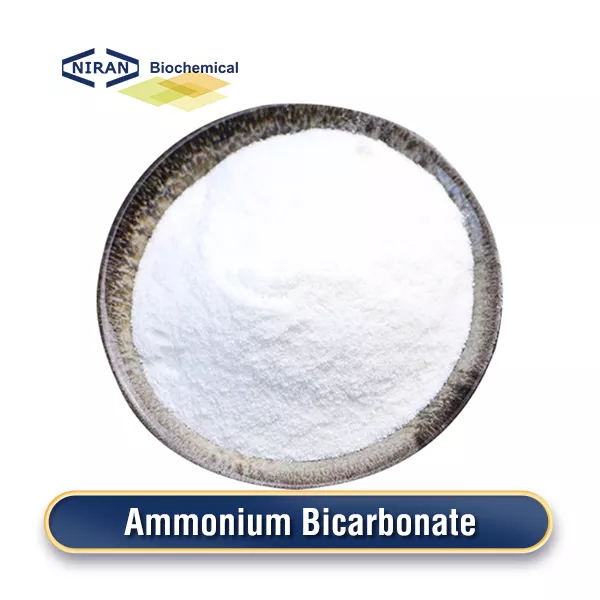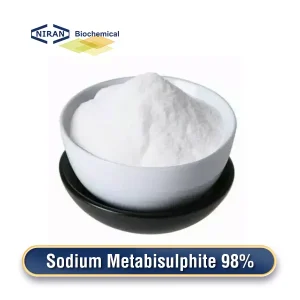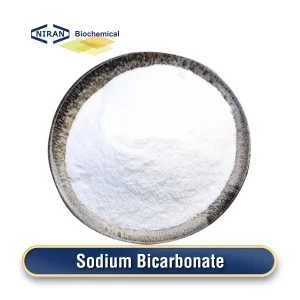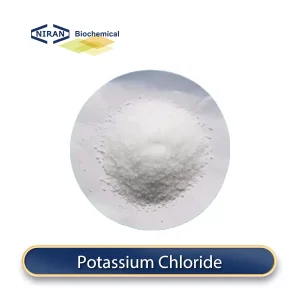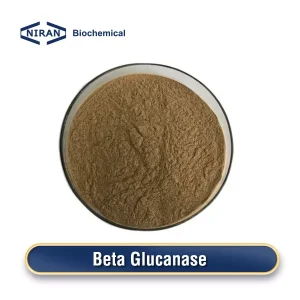Niran Biochemical
YOUR RELIABLE FOOD INGREDIENTS
Send Inquiry
Home » Products » Other Food Ingredients » Ammonium Bicarbonate
Ammonium Bicarbonate
- CAS: 1066-33-7
- Chemical Formula: NH₄HCO₃
- Certification: KOSHER, ISO, HALAL, FSSC22000, BRC, etc.
- MOQ: 1000KG
- Shelf Life: 2 Years
Inquire Product
Product Description
What is Ammonium Bicarbonate?
Ammonium bicarbonate is a white compound with white crystalline particles and an ammonia smell. When storing, be sure not to place it with acid, otherwise a chemical reaction will occur. It is extensively utilized in the chemical, feed, and food sectors.
There are several domestic preparation processes for ammonium bicarbonate:
- Ammonium bicarbonate synthesis method, which generates ammonium bicarbonate (NH4HCO3) by reacting ammonia (NH3) and carbon dioxide (CO2) in water. This is the most common industrial preparation method.
- Ammonium carbonate and ammonium hydroxide reaction method, as the name suggests, is to use ammonium carbonate and ammonium hydroxide to react to generate ammonium bicarbonate. This method needs to be carried out at appropriate temperature and conditions to control the selectivity of the reaction and the quality of the product.
Related parameters:
| ITEMS | STANDARD |
| Assay (as NH4HCO3, %) | ≤99.0-100.5 |
| Chlorides (as Cl, %) | ≤0.003 |
| Sulfur compound (as SO4, %) | ≤0.007 |
| Residue after evaporation (%) | ≤0.008 |
| Specific optical rotation | +20.5° ~ +21.5° |
| Lead | ≤3 mg/kg |
| Arsenic | ≤2 mg/kg |
| Total Heavy metal (as Pb) | ≤10 mg/kg |
Recommended dosage:
| Food name | Maximum usage(g/kg) |
| Bread and dough products | 1 – 5 g/kg |
| Cakes and pastries | 1 – 5 g/kg |
| Biscuits | 0.5 – 2 g/kg |
| 0.5 – 2 g/kg | 0.5 – 2 g/kg |
| Steamed buns and dumplings | 1 – 3 g/kg |
| Pizza | 1 – 3 g/kg |
| Candy | 0.1 – 0.5 g/kg |
| Chocolate products | 0.1 – 0.5 g/kg |
| Beverages | 0.1 – 0.3 g/kg |
| Dairy products | 0.1 – 0.3 g/kg |
| Seasonings | 0.1 – 0.3 g/kg |
| Prepared meat products | 0.1 – 0.3 g/kg |
| Seafood products | 0.1 – 0.3 g/kg |
| Pickled foods | 0.1 – 0.3 g/kg |
Ammonium Bicarbonate has a wide range of uses
- Leavening agent: Ammonium bicarbonate is a powerful leavening agent, especially suitable for dough and pastry products that require fast and strong fermentation. It decomposes at high temperatures to release ammonia and carbon dioxide, promoting dough expansion and increasing product volume.
- Brittle agent: During the baking process, ammonium bicarbonate can help products become brittle, and is particularly suitable for making biscuits, cookies and crackers, increasing their crisp taste.
- Alkaline regulator: As an alkaline regulator, ammonium bicarbonate can adjust the pH value of food, improve the elasticity and ductility of dough, and also affect the color and texture of baked products.
- Stabilizer: Ammonium bicarbonate can be used as a stabilizer to help maintain the volume and structure of the product and prevent the product from collapsing or deforming during the baking process.
User asked question:
Q: When you need to use ammonium bicarbonate and it is out of stock, what should you use to replace it?
A: 1. Baking Powder: Baking powder is a common substitute for ammonium bicarbonate in baking. Usually, it consists of three ingredients: starch, an acidic substance (such cream of tartar), and baking soda (sodium bicarbonate).
2. Baking Soda (Sodium Bicarbonate): Baking soda can also be used as a substitute, although it is not as strong a leavening agent as ammonium bicarbonate. To create carbon dioxide gas for leavening, an acidic component is needed, like as vinegar or lemon juice.
3. Yeast: Yeast is another alternative for leavening baked goods. Dough rises as a result of its reaction with carbohydrates to produce carbon dioxide during fermentation. However, yeast requires more time to ferment dough compared to chemical leavening agents like ammonium bicarbonate.
4. Double-Acting Baking Powder: When this kind of powder comes into contact with liquid, it produces carbon dioxide gas first; then, when it is heated during baking. It provides a more controlled rise similar to ammonium bicarbonate.

